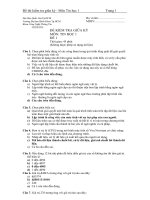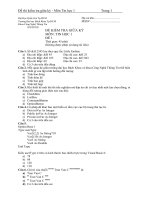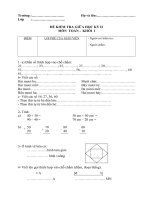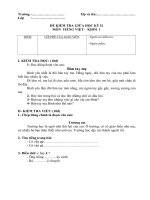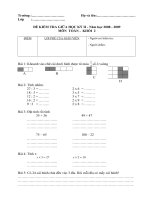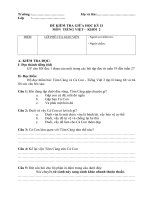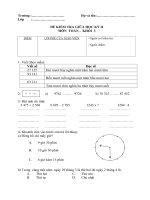ĐỀ THI KIỂM TRA GIỮA HỌC KỲ I Năm học: 2010-2011 - TRƯỜNG THPT BC NGUYỄN VIỆT DŨNG docx
Bạn đang xem bản rút gọn của tài liệu. Xem và tải ngay bản đầy đủ của tài liệu tại đây (154.66 KB, 4 trang )
TRƯỜNG THPT BC NGUYỄN VIỆT DŨNG
- 1 -
ĐỀ THI KIỂM TRA GIỮA HỌC KỲ I
Năm học: 2010-2011
MÔN: TIẾNG ANH – LỚP 12
Thời gian làm bài: 60 phút (không kể thời gian phát đề)
A. PHẦN TRẮC NGHIỆM: (8ms)
Câu 1: Chọn từ có trọng âm chính nhấn vào âm tiết có vị trí khác với những từ còn lại
A. attract B. person C. signal D. instance
Câu 2: Chọn phương án đúng (A hoặc B, C, D) để hòan thành câu sau
In many cultures, people signify their agreement by…………………………….their head.
A. turning B. raising C. nodding D. pointing
Câu 3: Chọn phương án đúng (A hoặc B, C, D) để hòan thành câu sau
We……… Dorothy since last Saturday
A. don’t see B. haven’t seen C. didn’t see D hadn’t seen
Câu 4: Chọn phương án (A hoặc B, C, D) tương ứng với nghĩa của câu sau đây
“You have not done your homework well,” said the teacher to me.
A. The teacher told me I hadn’t done my work well.
B. The teacher told me I haven’t done my work well.
C. The teacher told me I hadn’t done your work well.
D. The teacher told me I hadn’t done his work well.
Câu 5: Xác định từ có gạch chân cần phải sửa, để câu sau trở thành chính xác
The children are so exciting about the trip tomorrow that they can’t sleep
A B C D
Câu 6: Chọn phương án đúng (A hoặc B, C, D) để hòan thành câu sau
I’ll come and see you before I……… for the States.
A. leave B. will leave C. have left D. shall leave
Câu 7: Chọn từ mà phần gạch chân có cách phát âm khác với những từ còn lại
A. wanted B. included C. decided D. noticed
Câu 8: Chọn phương án đúng (A hoặc B, C, D) để hòan thành câu sau
I hate…………………personal questions by newly-acquainted friends.
A. to be asking B. to be asked C. being asking D. of asking
Câu 9: Xác định từ có gạch chân cần phải sửa, để câu sau trở thành chính xác
After Tom eaten dinner, he wrote several letters and went to bed
A B C D
Câu 10: Chọn phương án đúng (A hoặc B, C, D) để hòan thành câu sau
She said she………………………………………………………………………………
A. was very tired last night. B. was very tired the night before.
C. had been very tired last night. D. had been very tired the night before
Câu 11: Chọn phương án đúng (A hoặc B, C, D) để hòan thành câu sau
I………….in the room right now.
A. am being B. was being C. have been being D. am
Câu 12: Chọn phương án đúng (A hoặc B, C, D) để hòan thành câu sau
Gold…………in California in the 19
th
century.
A. was discovered B. has been discovered C. were discover D. they discovered
Câu 13: Xác định từ có gạch chân cần phải sửa, để câu sau trở thành chính xác
We all know that we have to work hardly to earn a living ourselves and support the family
A B C D
Câu 14: Chọn từ có trọng âm chính nhấn vào âm tiết có vị trí khác với những từ còn lại
A. situation B. appropriate C. informality D. entertainment
TRƯỜNG THPT BC NGUYỄN VIỆT DŨNG
- 2 -
Câu 15: Chọn phương án đúng (A hoặc B, C, D) để hòan thành câu sau
We want the kids to have the best………….education.
A. probable B. possible C. possibly D. probably
Câu 16: Chọn từ mà phần gạch chân có cách phát âm khác với những từ còn lại
A. laughs B. photographs C. machines D. parents
Câu 17: Chọn phương án đúng (A hoặc B, C, D) ứng với câu tốt nhất được tạo ra bằng các từ
cho sẵn
It / not / difficult / learn /English / if / you /study / structure / vocabulary / every day
A. It is not difficult learning English if you study structure and vocabulary every day
B. It is not difficult to learning English if you study structure and vocabulary every day
C. It is not difficult learning English if you studied structure and vocabulary every day
D. It is not difficult to learn English if you study structure and vocabulary every day
Câu 18: Xác định từ có gạch chân cần phải sửa, để câu sau trở thành chính xác
No one would have attended the lecture if you told the truth about the guest speaker
A B C D
Câu 19: Chọn phương án đúng (A hoặc B, C, D) để hòan thành câu sau
I have never seen such a beautiful dress…………………… you before
A. of B. for C. on D. in
Câu 20: Chọn phương án đúng (A hoặc B, C, D) để hòan thành câu sau
She apologized ………………………….waiting so long
A. to me for B. for keeping me C. for me D. for me keeping
Câu 21: Chọn phương án (A hoặc B, C, D) tương ứng với nghĩa của câu sau đây
Nobody can answer his questions.
A. His questions can be answered. B. His questions can’t be answered by any body
C. His questions could be answered D. His questions can’t be answered by nobody
Câu 22: Chọn phương án đúng (A hoặc B, C, D) để hòan thành câu sau
When I……… home last night, I discovered that Jane ………….a beautiful candle-lit dinner
A. arrived / had prepared B. arrived / prepared
C. had arrived / was preparing D. was arriving / prepared
Đọc kỹ bài khóa sau và chon phương án đúng (ứng với A hoặc B, C, D) cho các câu từ
câu 23 đến câu 27
Movements and gestures by the hands, arms, legs, and other parts of the body and face are
the most pervasive types of non-verbal messages and the most difficult to control. It is estimated
that there are over 200.000 physical signs capable of stimulating meaning in another person. For
example, there are 23 distinct eyebrow movements, each capable of stimulating a different
meaning.
Humans express attitudes toward themselves and vividly through body movements and
postures. Body movements express true messages about feelings that cannot be masked. Because
such avenues of communication are visual, they travel much farther than spoken words and are
unaffected by the presence of noise that interrupts, or cancels out speech.
People communicate by the way they walk, stand, and sit. We tend to be more relaxed with
friends or when addressing those of lower status. Body orientation is related to a more positive
attitude.
Body movements and postures alone have no exact meaning, but they can greatly support or
reject the spoken word. If these two means of communication are dichotomized and contradict
each other, some result will be a disordered image and most often the non-verbal will dominate.
23. Which part of body is not used to send body message?
A. faces B. legs C. hands D. stomachs
TRƯỜNG THPT BC NGUYỄN VIỆT DŨNG
- 3 -
24. Face gestures ………………………….
A. can help us control our feelings B. are the most difficult to control
C. cannot express our feelings D. do not include eye brow moments
25. Body communication is ………………………….
A. visual B. verbal C. very few D. uncommon
26. Non-verbal communication ………………………….
A. may be interrupted by noise. B. has no relation to verbal communication
C. dominates words. D. is less common than verbal communication.
27. According to the text, body movements cannot express………………………….
A. feelings B. status C. attitudes D. desires
Chọn từ thích hợp (ứng với A hoặc B, C, D) để điền vào chỗ trống trong đọan văn sau, từ
câu 28 đến câu 32
When eating, most Americans hold a fork in the ____(28)____ with which they write.
Americans eat away from home often, and usually they pay for their own meals when dining with
friends.
When Americans greet one another they often exchange a firm ___(29)____ . They may
greet strangers on the street by saying “Hello” or “____(30)____”. Friends often greet each other
with “How are you?” and respond “____(31)____”. Americans do not really expect any other
answer to the question “How are you?” because it is a way of ____(32)____. Except in formal
situations, people speak to each other by their given names once they are acquainted.
28. A. head B. mind C. notebook D. hand
29. A. adventure B. handshake C. militant D. occasion
30. A. Goodbye B. Good morning C. Not bad, thanks D. Take care
31. A. Bye B. So long C. No smoking D. Fine, thanks
32. A. having dinner B. shaking hands C. saying hello D. saying goodbye
B. PHẦN TỰ LUẬN (2ms)
Write about your family life. You should include the following main points:
- your parents and their jobs
- your brother(s) and/or sister(s)
- the interest(s) that the members of the family share closely
- each family member’s responsibility in the family
- some main family rules
ĐÁP ÁN: ĐỀ THI KIỂM TRA GIỮA HỌC KỲ I
1. A 11. D 21. B 31. D
TRƯỜNG THPT BC NGUYỄN VIỆT DŨNG
- 4 -
2. C 12. A 22. A 32. C
3. B 13. B 23. D
4. A 14. B 24. B
5. A 15. B 25. A
6. A 16. C 26. C
7. D 17. D 27. D
8. B 18. C 28. D
9. A 19. C 29. B
10. D 20. B 30. B


